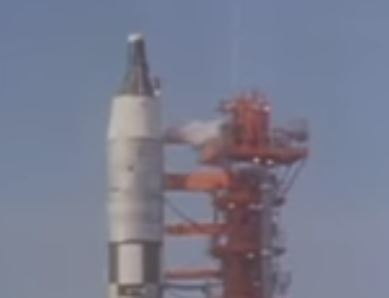 Space News space history and artifacts articles Messages space history discussion forums Sightings worldwide astronaut appearances Resources selected space history documents |
If you have previously registered, but forgotten your password, click here.
| ||||||||
| moorouge | Is this it -  | |||||||
| space1 | Yes. | |||||||
| Fra Mauro | Thanks for the video. I do recall the testing of the LM's RCS on the moon. | |||||||
| Headshot | That sure looks like the OAMS testing (if that is indeed what it is) that I recall, but in this case (Gemini V) it is much more visible than what I remember. I believe the visibility of the puffs depended on wind speed, lighting conditions and camera angle (having that red umbilical tower behind the puffs helped provide contrast). Good job in locating that video. | |||||||
| LM-12 | Here is some 16mm footage taken of the LM liftoff on Apollo 14. Look closely at the first few seconds. In the first scene, you see the S-band antenna shadow. In the second scene, you don't. The RCS test must have taken place between the two scenes. Notice also how the flag has moved. | |||||||
| LM-12 | There is this entry in Volume IV of "The Apollo Spacecraft - A Chronology" for October 28, 1968: MSC Apollo Spacecraft Program Office Manager George M. Low deleted the requirement for a short static-firing of the Apollo 8 service module reaction control system on the pad before launch (the so-called "burp" firing). He took this move in line with a recommendation from NASA Apollo Program Director Samuel C. Phillips and in light of the nominal performance of the RCS during the Apollo 7 flight. By thus eliminating the burp firings — and not allowing any contact of the system's hypergolic propellants — the spacecraft could be maintained in a loaded condition through the December and January launch windows and gain the maximum launch flexibility for the Apollo 8 flight. (Decisions not to static-fire the RCS systems on spacecraft following 103 had been made some time earlier.) | |||||||
| LM-12 | The Apollo 7 Press Kit has a "spacecraft RCS static fire" test at T-20 minutes in the countdown events. From the PAO transcript: This is Apollo Saturn Launch Control at T-21 minutes and counting. T-21, at this time the commander of the Apollo 7 Spacecraft, Wally Schirra, has gone through a series of checks with the reaction control system on the Apollo 7 Spacecraft. We have a total of some 16 reaction control system engines on the service module of the Apollo 7. They're located in four quadrants around the service module and each of the engines is capable of generating some 100 lbs. of thrust. Astronaut Schirra fired these thrusters and the report from the Spacecraft Test Conductor is the static firing went very well. We actually did fire several of the thrusters during this test and the report was that the test went well. In the meantime we completed some final checks of the range safety destruct system aboard the Saturn lB launch vehicle. These are checks between the launch crew and the Air Force Eastern Test Range. Those checks also went very well, and the count is continuing. We have just passed the 20 minute mark. We are now at T-19 minutes, 54 seconds and counting. This is Launch Control. | |||||||
